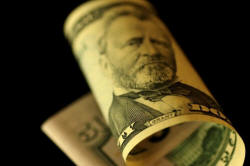Dollar pushes toward 3-month highs again as euro
struggles
 Send a link to a friend
Send a link to a friend
 [April 30, 2018]
By Masayuki Kitano [April 30, 2018]
By Masayuki Kitano
SINGAPORE (Reuters) - The dollar rose on
Monday and held just below its strongest level since mid-January, with
weaker-than-expected German retail sales knocking euro zone sentiment as
investor appetite for the greenback improves.
After weakening at the start of 2018, a rise in U.S. Treasury yields
have helped the dollar stage a recovery in the past fortnight at the
same time as doubts grow about when the European Central Bank (ECB) will
tighten monetary policy.
U.S. consumer spending numbers, due out of the U.S. later on Monday
along with the Federal Reserve's monetary policy meeting and a crucial
jobs report scheduled for later in the week, could help the dollar rally
further, analysts said.

"With U.S. yields meandering around the 3 percent mark, in the near term
the dollar can definitely rise further," Societe Generale FX strategist
Alvin Tan said. "That said, we think longer term the euro can move
higher."
The 10-year U.S. Treasury yield hurdled 3 percent last week <US10YT=RR>
and remains close to that level, encouraging investors to buy the
dollar.
Positioning data shows that net long euro positions by speculators fell
last week, albeit it from a record high, suggesting investors remain
overwhelmingly bullish on the single currency but are reducing those
bets.
The dollar's index rose 0.3 percent to 91.780 <.DXY>, down from Friday's
high of 91.986, its strongest level since Jan. 11.
The dollar last week enjoyed its biggest weekly gain in more than two
months, and the U.S. currency began this week on a strong footing.
German monthly retail sales unexpectedly dropped in March, dampening
cheer around a consumer-led upswing in Europe's biggest economy.
Regional data showed annual inflation in four German states steady in
April, suggesting price pressures in Europe's largest economy are
stable.
[to top of second column] |

A U.S. Dollar note is seen in this June 22, 2017 illustration photo.
REUTERS/Thomas White/Illustration/File Photo

The euro dropped 0.4 percent to $1.2088 <EUR=>, not far from its three-month
lows last week of $1.2110.
RATE CORRELATION BACK?
The correlation between U.S. yields and the dollar had broken down earlier this
year as investors focused more on trade frictions and geopolitical issues. But
markets have recently turned their attention back to interest rate plays as
concerns over the U.S.-China trade dispute and tensions over North Korea's
nuclear programme calmed, giving the greenback a leg up.
Positive earnings from U.S. technology firms and marquee M&A deals have also
helped sentiment into this week.
"Even if the rate expectations for the euro zone have recently eased they remain
too high in our view. We expect a further downside correction over the course of
the year, which is likely to put pressure on the euro in the end," Commerzbank
analysts said.
Elsewhere, the dollar rose versus the Japanese currency, up 0.2 percent to
109.25 yen <JPY=>, having set a 2-1/2 month high of 109.54 yen on Friday.
Trading was thin with Japanese markets closed for a holiday.
Sterling tumbled further, hitting a low of $1.3715 <GBP=>, as the dollar gained
and investors further trimmed expectations that the Bank of England would raise
rates next month following weak first-quarter GDP data published last week.

The U.S. currency also gained versus the Canadian <CAD=> and Australian <AUD=>
dollars, the latter down half a percent and close to its 4-1/2 month low reached
last week.
(Reporting by Masayuki Kitano; Editing by Sam Holmes and Kim Coghill)
[© 2018 Thomson Reuters. All rights
reserved.] Copyright 2018 Reuters. All rights reserved. This material may not be published,
broadcast, rewritten or redistributed.
Thompson Reuters is solely responsible for this content. |